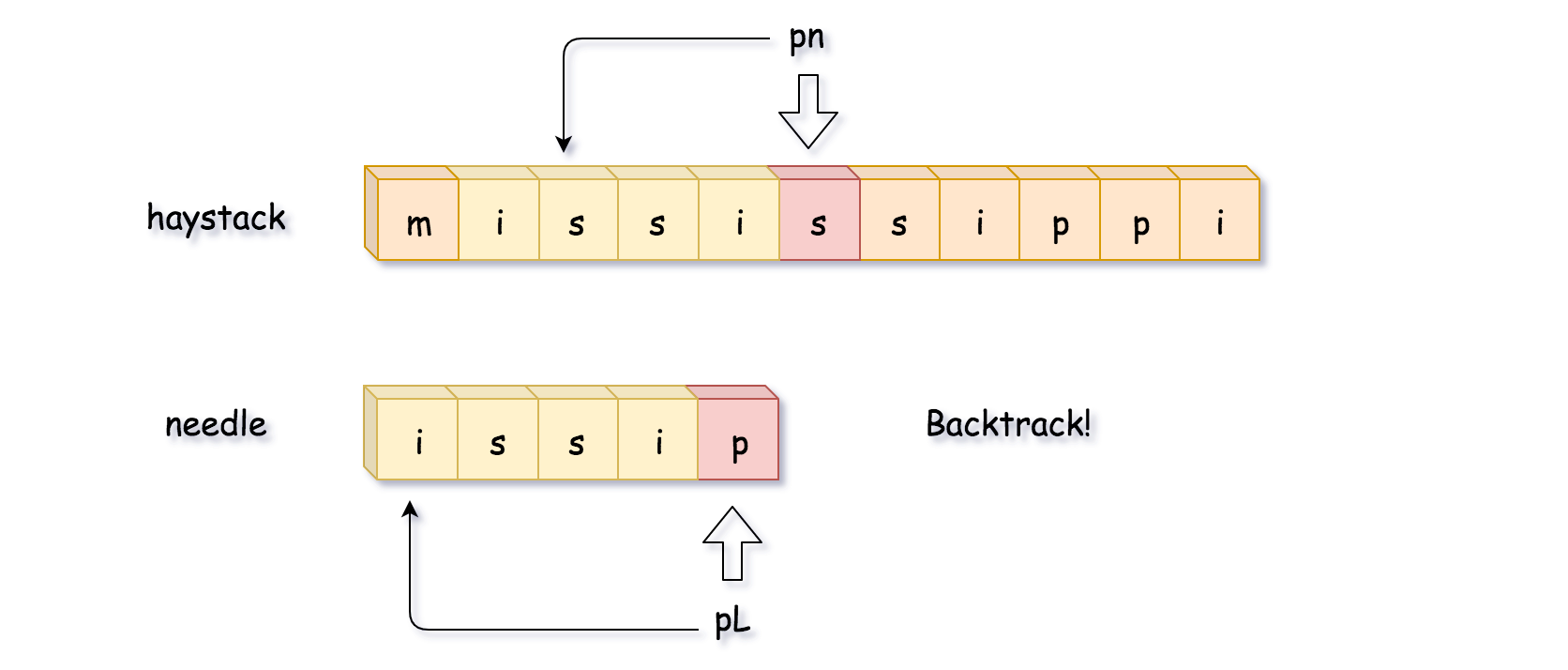实现strStr()(leetcode28)
实现 strStr() 函数。
给定一个 haystack 字符串和一个 needle 字符串,
在 haystack 字符串中找出 needle 字符串出现的第一个位置 (从0开始)。
如果不存在,则返回 -1。
示例 1:
输入: haystack = "hello", needle = "ll" 输出: 2
解析:
方法一:子串逐一比较
最直接的方法 - 沿着字符换逐步移动滑动窗口,将窗口内的子串与 needle 字符串比较

public class leetcode28 { public static void main(String[] args) { // TODO Auto-generated method stub String haystack = "hello"; String needle = "ll"; System.out.println(strStr(haystack,needle)); } public static int strStr(String haystack,String needle){ int n = haystack.length(); int l = needle.length(); for(int i=0;i<n-l+1;i++){ if(haystack.substring(i,i+l).equals(needle)){ return i; } } return -1; } }
方法二:双指针
上一个方法的缺陷是会将haystack所有长度L的子串都与needle比较,实际上不需要。
首先,只有子串的第一个字符跟needle字符串第一个字符相同的时候才比较。
其次,可以一个字符一个字符的比较,一旦不匹配了就立刻终止。
如下图,比较到最后一位发现不匹配,然后开始回溯。
需要注意,pn指针是移动到pn = pn - curr_len + 1的位置,而不是pn = pn - curr_len的位置。
即移动到下一个开始的位置,再依次对比。

算法
移动 pn 指针,直到 pn 所指向位置的字符与 needle 字符串第一个字符相等。
通过 pn,pL,curr_len 计算匹配长度。
如果完全匹配(即 curr_len == L),返回匹配子串的起始坐标(即 pn - L)。
如果不完全匹配,回溯。使 pn = pn - curr_len + 1, pL = 0, curr_len = 0。
class Solution { public int strStr(String haystack, String needle) { int L = needle.length(), n = haystack.length(); if (L == 0) return 0; int pn = 0; while (pn < n - L + 1) { // find the position of the first needle character // in the haystack string while (pn < n - L + 1 && haystack.charAt(pn) != needle.charAt(0)) ++pn; // compute the max match string int currLen = 0, pL = 0; while (pL < L && pn < n && haystack.charAt(pn) == needle.charAt(pL)) { ++pn; ++pL; ++currLen; } // if the whole needle string is found, // return its start position if (currLen == L) return pn - L; // otherwise, backtrack pn = pn - currLen + 1; } return -1; } }






【推荐】国内首个AI IDE,深度理解中文开发场景,立即下载体验Trae
【推荐】编程新体验,更懂你的AI,立即体验豆包MarsCode编程助手
【推荐】抖音旗下AI助手豆包,你的智能百科全书,全免费不限次数
【推荐】轻量又高性能的 SSH 工具 IShell:AI 加持,快人一步
· AI与.NET技术实操系列:基于图像分类模型对图像进行分类
· go语言实现终端里的倒计时
· 如何编写易于单元测试的代码
· 10年+ .NET Coder 心语,封装的思维:从隐藏、稳定开始理解其本质意义
· .NET Core 中如何实现缓存的预热?
· 分享一个免费、快速、无限量使用的满血 DeepSeek R1 模型,支持深度思考和联网搜索!
· 基于 Docker 搭建 FRP 内网穿透开源项目(很简单哒)
· 25岁的心里话
· ollama系列01:轻松3步本地部署deepseek,普通电脑可用
· 按钮权限的设计及实现
2020-03-09 前端学习(45)~正则表达式
2020-03-09 前端学习(44)~js学习(二十一):包装类
2020-03-09 前端学习(43)~js学习(二十):内置对象 - String
2020-03-09 前端学习(42)~js学习(十九):内置对象-Date
2020-03-09 前端学习(41)~js学习(十八):内置对象:Math